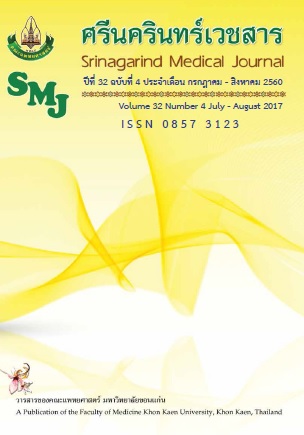Effectiveness of Health Education Methods for Preventing Liver Fluke Infection: Systematic Review and Meta-analysis
Keywords:
การให้สุขศึกษา, มะเร็งท่อน้ำดี, Opisthrochis viverrini, Clonorchis sinensis, พยาธิใบไม้ตับAbstract
Background and Objective:Prevention of liver fluke infection Opisthorchis viverrini and Clonorchis sinensis is a strategy to reduce Cholangiocarcinoma incidence. Many studies evaluated the effectiveness of health education methods for preventing liver fluke infection. However, there is not clear evidence of the prevention. This study was aimed to conduct a systematic review for evaluating the effectiveness of health education methods for preventing liver fluke infection.
Methods:We searched electronics databases of PubMed, SCOPUS, ISI, and Cochrane library, including Thai medical and public health journals. We also considered the reference lists of the retrieved studies. The search keywords included health education, control effectiveness, strategy, liver fluke, raw fish, O. viverrini, C. sinensis. We included randomised or quasi-randomised trials. Two review authors independently screened studies based on the pre-specified inclusion criteria, extracted data, and assessed the studied risk of bias. We assessed heterogeneity among the included studies results by using I square, Tau square and Chi square statistics. We assessed effectiveness of health education by using standardized mean difference (SMD) for continuous data and risk ratio (RR) for binary data.
Results:We included 26 studies involved 17,882 participants. Three studies were randomized controlled trials. Twenty-five studies were conducted in Thailand. All twenty six studies were assessed as at high risk of bias. We found health education methods gave statistically significant higher scores of prevention of liver fluke than those for the routine method (Pooled SMD; Random 1.18; 95% CI: 0.87 to 1.50) and lower liver fluke infection than routine health education (Pooled RR; Random 0.57; 95% CI: 0.47to 0.69)
Conclusions: We found low-quality evidence that health educations have a little effectiveness for preventing liver fluke infection when compared with regular practices in all groups of population.
ประสิทธิผลของวิธีการทางสุขศึกษาในการป้องกันการติดเชื้อพยาธิใบไม้ตับ: การทบทวนวรรณกรรมอย่างเป็นระบบและการวิเคราะห์เมตต้า
ปวีณา นามโคตร1, ศิริพร คำสะอาด2 * , มาลินี เหล่าไพบูลย์ 2, สุพจน์ คำสะอาด3, พรรณี บัญชรหัตถกิจ4
1นักศึกษาหลักสูตรสาธารณสุขศาสตรมหาบัณฑิต สาขาวิชาชีวสถิติ คณะสาธารณสุขศาสตร์ มหาวิทยาลัยขอนแก่น
2 สาขาวิชาวิทยาการระบาดและชีวสถิติ คณะสาธารณสุขศาสตร์ มหาวิทยาลัยขอนแก่น
3หน่วยมะเร็ง โรงพยาบาลศรีนครินทร์ คณะแพทยศาสตร์ มหาวิทยาลัยขอนแก่น
4สาขาวิชาการบริหารสาธารณสุข การส่งเสริมสุขภาพ โภชนาการ คณะสาธารณสุขศาสตร์ มหาวิทยาลัยขอนแก่น
หลักการและวัตถุประสงค์:การป้องกันการติดเชื้อพยาธิใบไม้ตับชนิด Opisthorchis viverrini และ Clonorchis sinensis เป็นกลยุทธ์หนึ่งเพื่อลดอุบัติการณ์ของมะเร็งท่อน้ำดี มีรายงานวิจัยประสิทธิผลของวิธีการทางสุขศึกษาในการป้องกันการติดเชื้อพยาธิใบไม้ตับจำนวนมาก แต่ยังไม่มีข้อสรุปที่ชัดเจน การศึกษานี้จึงมีวัตถุประสงค์เพื่อประเมินประสิทธิผลของวิธีการทางสุขศึกษาต่อการป้องกันการติดเชื้อพยาธิใบไม้ตับโดยการทบทวนวรรณกรรมอย่างเป็นระบบและวิเคราะห์เมตต้า
วิธีการศึกษา: สืบค้นรายงานวิจัยในฐานข้อมูลอิเล็กทรอนิกส์ ได้แก่ PubMed, SCOPUS, ISI และ Cochrane library รวมทั้งวารสารทางการแพทย์และสาธารณสุขไทย และเอกสารอ้างอิงในงานวิจัยที่สืบค้นได้ คำสำคัญคือ Health education, Control effectiveness, Strategy, Liver fluke, Raw fish, Opisthrochis viverrini, Clonorchis sinensis เลือกรายงานวิจัยเชิงทดลองแบบสุ่ม หรือกึ่งทดลอง นักวิจัยสองคนคัดเลือกรายงานวิจัยเข้าตามเกณฑ์ที่กำหนด ดึงข้อมูล และประเมินอคติ โดยทำอย่างเป็นอิสระต่อกัน การประเมินความแตกต่างระหว่างรายงานวิจัยพิจารณาจากค่าสถิติไอกำลังสอง ค่าทาวกำลังสอง และค่าไคกำลังสอง ประเมินประสิทธิผลของวิธีการทางสุขศึกษา โดยใช้ค่าความแตกต่างของค่าเฉลี่ยกรณีข้อมูลต่อเนื่อง และอัตราส่วนความเสี่ยงกรณีข้อมูลทวินาม
ผลการศึกษา: รายงานวิจัยที่ผ่านเกณฑ์การคัดเข้า 26 รายงาน ศึกษาในตัวอย่างทั้งสิ้น 17,882 ราย 3 รายงาน มีรูปแบบการศึกษาเชิงทดลองแบบสุ่ม 25 รายงาน ศึกษาในประเทศไทย ทั้ง 26 รายงาน วิจัย มีความเสี่ยงต่อการเกิดอคติสูง ผลการวิเคราะห์เมตต้าพบกลุ่มที่ได้รับวิธีการทางสุขศึกษามีค่าเฉลี่ยมาตรฐานคะแนนการปฏิบัติตนสูงกว่ากลุ่มที่ได้รับบริการปกติ (Pooled standardized mean difference; Random 1.18; 95% CI: 0.87 ถึง 1.50) และมีการติดเชื้อน้อยกว่ากลุ่มที่ได้รับบริการปกติ (Pooled risk ratio; Random 0.57 เท่า; 95% CI: 0.47 ถึง 0.69 เท่า)
สรุป: หลักฐานที่พบมีคุณภาพไม่ดี และให้ข้อสรุปว่า วิธีการทางสุขศึกษามีประสิทธิผลในการป้องกันการติดเชื้อพยาธิใบไม้ตับได้น้อยเมื่อเทียบกับวิธีปกติในทุกกลุ่มประชากร




